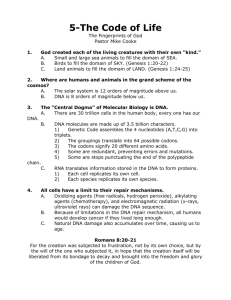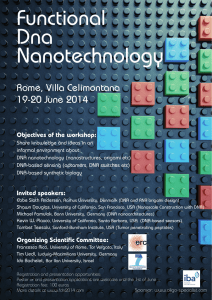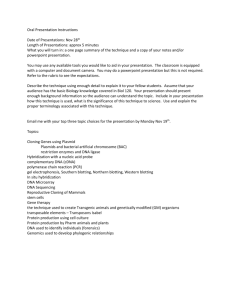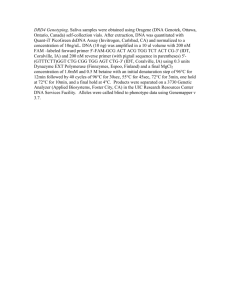BIO-109 - Springfield Technical Community College
advertisement
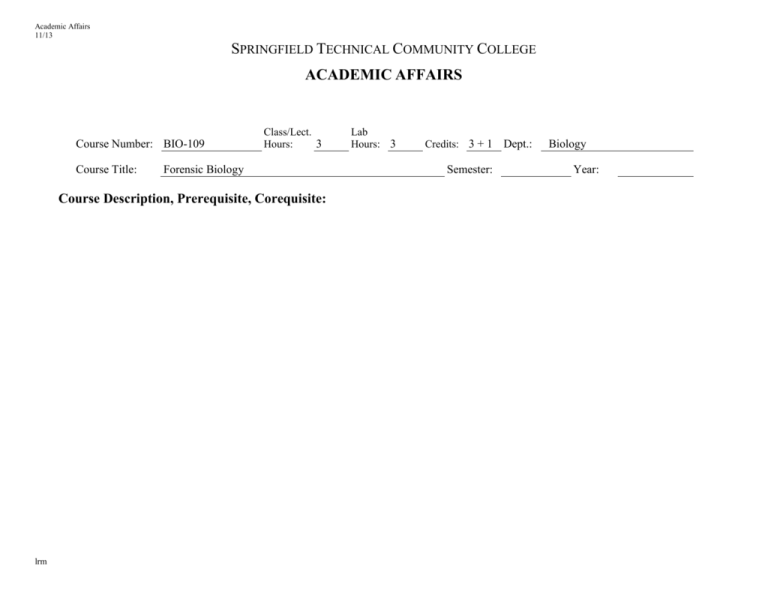
Academic Affairs 11/13 SPRINGFIELD TECHNICAL COMMUNITY COLLEGE ACADEMIC AFFAIRS Course Number: BIO-109 Course Title: Class/Lect. 3 Hours: Forensic Biology Course Description, Prerequisite, Corequisite: lrm Lab Hours: 3 Credits: 3 + 1 Semester: Dept.: Biology Year: Course Number: Page 2 Course Objectives Competencies Course Number: Page 3 Primary learning goals addressed: 1. Quantitative literacy 2. Critical thinking 3. Computer literacy 4. Written and oral communication 5. Information literacy Understand forensic science and forensic biology and the role of the forensic biology investigator. 1. Define and distinguish criminalistics, forensic science and forensic biology. 2. Describe the parameters under which scientific evidence may be introduced into a court proceeding. 3. Compare and contrast the Frye and Daubert decisions and their role in defining the admissibility of scientific evidence. 4. Explain the role of the expert witness. Understand defining and managing a crime scene and maintaining the chain of custody of evidence. 1. Describe the nature of physical evidence. 2. Describe the role of the police officer who is first to arrive at the scene. 3. State the steps in defining, securing and isolating a crime scene. 4. Describe the appropriate methods for searching a crime scene. 5. Describe basic appropriate parameters for gathering data from a crime scene. 6. Describe the nature of the chain of custody and how it is maintained. Understand and be prepared to implement the scientific method. Communicate the scientific features of forensic science. 1. State the steps in the scientific method. 2. Distinguish between scientific hypothesis and theory. Course Number: Page 4 3. When confronted with a problem ameneable to the scientific method, demonstrate the ability to define a hypothesis, a single question that will address that hypothesis, and the ability to define the appropriate data that needs to be collected to help answer that question. 4. Demonstrate the ability to critique the quality of data and its ability to shed light on the question derived from a hypothesis. 5. Apply the scientific method to situations involving forensic evidence. Be able to use the metric system. 1. Express any number in scientific notation. 2. Find the number of significant figures in a measurement. 3. Express answers to calculations in the proper number of significant figures. 4. Set up and solve problems utilizing the method of dimensional analysis (factor-label method). 5. Convert from a metric unit to the corresponding English unit using the factor-unit method. 6. Convert from an English unit to the corresponding metric unit using the factor-unit method. 7. Make temperature conversions among Fahrenheit and Celsius scales. Know the parts of the cell and how they interact to create basic cell functions. Course Number: Page 5 1. State the primary structural divisions of a cell (membrane, cytoplasm, nucleus) and their fundamental roles. 2. Name the cellular organelles and state the basic function of each. 3. Describe the structure of cellular membranes and how this structure is important for cellular function. 4. Describe how cells transport material across membranes. 5. Describe ways in which membranes contribute to intracellular communication. 6. Describe the cellular level of action of some common poisons. Understand the concepts of serology 1. Describe the nature of antigens found on blood cells and their role in normal functioning. 2. Describe the nature of antibodies and their role in normal functioning. 3. Relate the roles of antibodies and antigens to previously discussed concepts of membrane biology. Describe techniques for identifying various biological fluids. Demonstrate the ability to reconstruct aspects of a violent crime from blood spatter anaylsis. 1. Learn the tests required for identifying occult blood stains at a crime scene. 2. Learn techniques for properly collecting and preserving bodily fluid evidence. 3. List laboratory tests used to characterize semen, saliva, and blood stains. 1. State aspects of information that can be obtained through bloodstain analysis at a crime scene. 2. Describe the various factors that can affect the shape of bloodstains (texture of surface, direction of spatter, angle of impact). 3. Describer how velocity and angle of impact affects spatter patterns. 4. Describe methods to infer area of origin of spatter patterns. 5. Describe other influences on blood spatter patterns. 6. Describe how patterns are documented at a crime scene. Course Number: Page 6 Understand how various blood typing techniques work. 1. 2. 3. 4. List the four basic blood types (A, B, AB, O). Describe inheritance of a single gene using a Punnett square. Describe how the antibodies used in blood typing are produced. Describe the difference in how polyclonal and monoclonal antibodies are made and the difference in their function. 5. Describe laboratory techniques for using antibody based assays to characterize blood types, bodily fluid stains and molecules found in the blood. Understand the structure of the DNA molecule 1. 2. 3. 4. Describe the structure of individual nucleotides. Describe how DNA nucleotides are formed into single stranded DNA. Describe how DNA strands form the double helix. Describe the nature of chromosomes and their relation to DNA polymers. 5. Understand and describe the overall primary, secondary and tertiary structure of DNA. 6. Explain how the structure of DNA is important for its role in heredity. Understand the role of DNA in cells. Understand sources of DNA in a cell and sources of DNA as evidence. 1. State the steps in the mechanisms of transcription. 2. State the steps in the mechanism of translation. 3. Describe one pr more processes by which transcription and translation lead to an expression of phenotype. Course Number: Page 7 Course Objectives Describe methods for extracting and quantitizing DNA and describe why this is an important step in DNA analysis. Competencies 1. Distinguish between nuclear, mitochondrial and chloroplast DNA and how they are different. 2. Distinguish between DNA and RNA. 3. Describe the nature of DNA in bacteria. 4. Describe possible locations and sources of DNA evidence at a crime scene. 5. Describe location and nature of possible DNA evidence in a rape investigation. 1. Describe physical methods for isolating DNA from cells and tissues and as a physical component of evidence found at crime scenes. 2. Describe how isolation techniques depend on the chemical nature of DNA as compared to proteins, lipids or carbohydrates. 3. Describe the importance of quantitizing the amount of DNA in a sample. 4. Describe methods for quantitization of DNA. 1. Describe the theoretical principles of DNA electrophoresis. 2. Describe an electrophoresis apparatus and the reagents used. 3. Distinguish between agarose and polyacrylamide gel electrophoresis among other techniques. 4. Interpret electrophoresis output and state the advantages and disadvantages of the technique. 1. Describe the theoretical principles of PCR. 2. Describe why PCR is important and useful in crime scene analysis and DNA analysis in general. 3. Describe the steps in PCR and state the apparatus used. 4. State factors that can affect the reliability of PCR. 1. Describe the nature and function of the CODIS DNA database. Course Number: Page 8 2. Discuss how DNA profiling is combined with vthe CODIS database in criminal investigations. 3. Describe how CODIS is linked with other databases. Understand the process of DNA electrophoresis and the information it can provide. Understand the use of the polymerase chain reaction (PCR) to amplify a DNA sample. Know the major DNA database used in forensics and its role in DNA profling 1. Describe what STRs are. 2. State the biological role of STRs in relation to the rest of the genetic code. 3. Describe how STRs can be used in DNA profiling. 4. Describe how DNA extraction, electrophoresis and PCR can play a role in STR analysis. 1. 2. 3. 1. 4. 2. 3. 1. 2. 3. 4. State the structure of the Y chromosome and its biological role. Describe the unique heredity pattern of the Y chromosome. State why the Y chromosome is particularly useful in DNA profiling. Describe techniques for Y chromosome analysis. State the structure of mDNA and its biological role. Describe the unique heredity pattern of mDNA. State why mDNA is particularly useful in DNA profiling. Describe techniques for mDNA analysis. Understand the nature of Short Tandem Repeats (STRs) in the genetic code, their biological role, and their role in DNA profiling. Understand the role of the Y chromosome and why it is useful in genetic profiling. 1. Describe what SNPs are. 2. State the biological role of SNPs in relation to the rest of the genetic code. 3. Describe how SNPs can be used in DNA profiling. 4. Contrast and compare the use of STRs, Y chromosome, mDNA and SNPs in DNA profiling. 1. Describe how microbe DNA may differ from human DNA. Course Number: Page 9 Course Objectives Understand the role of mitochondrial DNA (mDNA) and why it is useful in genetic profiling. Understand the nature of Single Nucleotide Polymorphisms (SNPs) in the genetic code, their biological role, and their role in DNA profiling. Understand methods of identifying non-human DNA in samples. Understand issues connected with using DNA as evidence. Competencies 2. Describe other sources of DNA that may contaminate a sample. 3. Describe approaches to identify non-human DNA in a sample and possible uses of non-human DNA in a criminal investigation. 1. Describe factors affecting the frequency of certain combinations of DNA sequences in a population. 2. State proper handling procedures for DNA samples and why these are important. 3. State issues connected with the need for properly calibrated equipment and reliable DNA standards and issues connected with these.




